Fleas are small (1/16 inch or 16 mm), dark, reddish-brown, wingless, blood-sucking insects. Their bodies are laterally compressed (flattened side to side), permitting easy movement through the hairs on the host's body. Their legs are long and well adapted for jumping. The flea body is hard, polished, and covered with many hairs and short spines directed backward. The mouthparts of an adult flea are adapted for sucking blood from a host.
Several species of fleas may be pests in Florida. The cat flea (Figure 1) is the most frequently found flea. Cat fleas may attack a wide variety of warm-blooded animals including dogs, humans, chickens, rabbits, squirrels, rats and mice. Although the dog, human, and sticktight fleas are also found in Florida, multiple species of fleas may be found on a single animal.
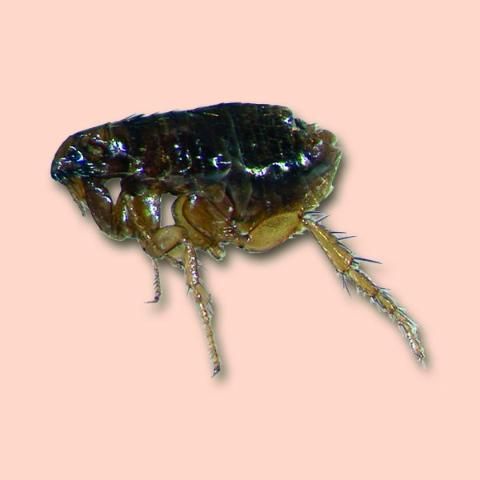
Biology
The female flea lays her tiny, white eggs (Figure 2) loosely on the hairs, in the feathers, or in the habitat of the host. The eggs readily fall off the host onto the ground, floors, bedding, or furniture. Some fleas can lay 500 eggs over a period of several months by laying batches of three to 18 eggs at a time. The tiny eggs hatch in one to 12 days after being deposited. The white, wormlike larva (Figure 3) avoids light and feeds on dried adult feces mainly, but may feed on dead animal parts and other organic matter. Within seven to 14 days, unless food has been scarce, the third larval stage is completed, and the larva spins a tiny cocoon (Figure 4) and pupates. Usually after a week the adult flea emerges and begins its search for blood.
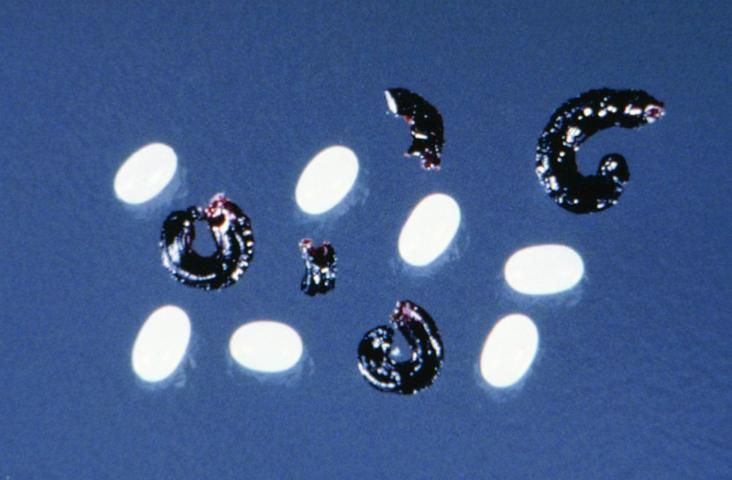
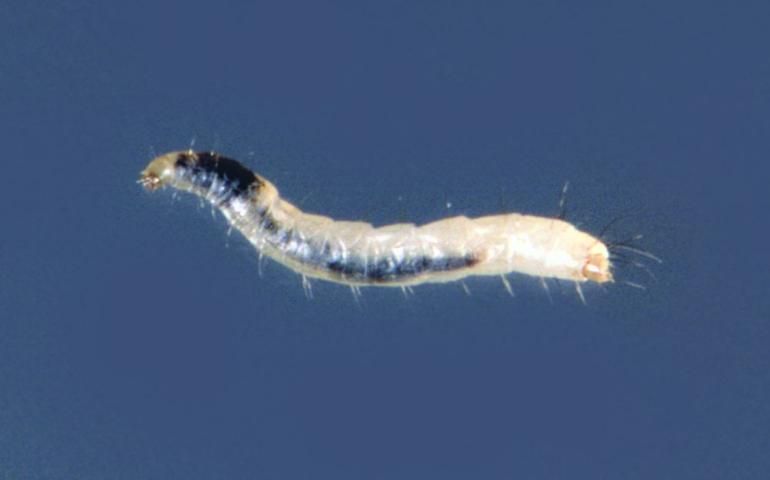
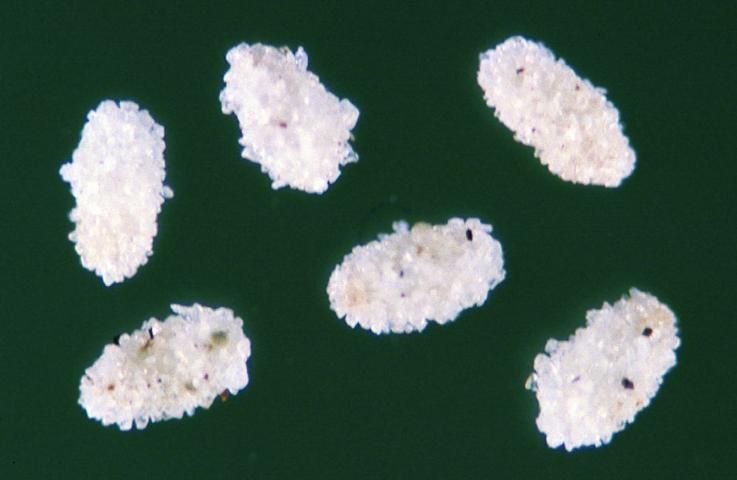
However, fleas are known to remain in the pupal stage from five days to five weeks in the absence of hosts. Adults emerge from the pupal case when vibrations from pets or humans let them know a host is near. This is one reason why people returning to an unoccupied home may suddenly be attacked by an army of fleas.
Adult fleas must feed on blood in order to reproduce; however, adults can live for long periods without feeding. Fleas usually live and breed most heavily where pets rest. Persons coming near these resting places are also subject to attack. If fleas are established in a home, they will feed on humans as well as on the pets. The usual places of attack are the ankles and lower portions of the legs.
The so-called "sand-flea" is nothing more than a common flea that is breeding outdoors in the soil. Contrary to belief, fleas cannot go through several generations without having a blood meal.
The entire life cycle (Figure 5) of a flea can require two weeks to two years. Hot, wet, summer months favor egg laying. Hot, dry periods give maximum adult production, so greatest adult flea populations are produced in August to September.
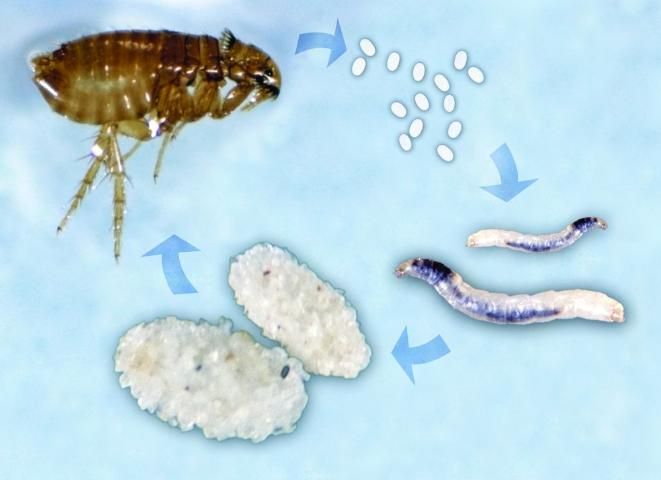
Importance
Fleas often breed in large numbers where pets and other animals live. Pets infested with fleas bite and scratch themselves constantly. Their coats become roughened, and the skin can become infected. Symptoms of sensitized hosts are often mistaken for mange. Cat fleas and dog fleas may be intermediate hosts for the dog tapeworm.
Some people suffer more than others from flea bites. The bites can cause intense itching, often resulting in secondary infection. The usual flea bite has a small red spot where the flea has inserted its mouthparts. Around the spot there is a red halo with very little swelling. Many people do not react to flea bites at all, while others are sensitive and suffer severe allergic reactions. Fleas may also vector such human diseases as plague, typhus, and tularemia.
Control
Flea control is difficult for pet owners to implement because two things may have to be done: (1) treat the pet and (2) treat the premises. Pet treatment alone is often sufficient because the animal removes and treats fleas from infested premises. Humans are often bitten by fleas when they enter infested areas. Repellents can be applied in order to keep fleas from biting.
On-Animal Treatment
On-animal flea control is the most popular and effective method of controlling fleas (Table 1). The animal is treated with product and attracts fleas onto its body when it moves through infested areas. The fleas are then killed by contact with spot-on and spray products or by feeding on treated blood from application by pills or oral liquids. Many of these products can kill fleas before they have a chance to bite flea-allergic animals. With this method of treatment, much less product is used than for insecticide treatment of premises, which mainly kills the immature stages of fleas. It is important to make sure to use the correct amount of product because many products are dispensed according to the weight of the animal. Also, most on-animal products cannot be used on young puppies and kittens.
Pets may be combed or shampooed frequently to remove adult fleas before they can irritate the pet or lay eggs. Frequent removal of fleas can reduce flea infestations quite effectively.
Veterinarians may prescribe or apply pesticides not available over the counter. Oral flea medication prescribed by veterinarians can provide control of fleas when pets are not allowed outdoors and effective flea control is accomplished in the house and yard. Topical or spot treatment provides effective residual control.
To be certain pets remain free of fleas, it is necessary to make routine use of flea control products, especially if pets are allowed contact with infested animals or premises.
Premise Treatment
Pets become reinfested with fleas from premises. For the most effective control, sleeping areas, bedding, kennels, and other areas frequented by the animal should be treated at the time the pet treatment is made. Treatments may or may not include the use of pesticides.
Nonpesticidal premise control includes thorough and frequent cleaning of the house. All rugs should be thoroughly cleaned with a vacuum cleaner or a steam cleaner. Infested furniture, pet baskets, and cracks should be thoroughly cleaned to prevent the larvae from finding food. Dirt that is collected should be disposed of immediately to destroy fleas and flea larvae.
Many people remove pets from the home to attempt flea control. Flea infestations usually become more evident when pets are removed. Although the hungry adult fleas prefer to feed on cats and dogs, when the pet is removed the fleas overrun the home, frequently attacking humans. Dogs and cats can be used to attract fleas from the premises. Recommended pet treatments at frequent intervals can be used to kill the fleas.
Insect growth regulators (IGRs) are the most effective chemicals and are found in some indoor, space, and surface treatments. Common IGRs are methoprene, hydroprene, and piriproxyfen. These may be used in conjunction with residual sprays to quickly reduce adult populations. IGRs prevent flea larvae from turning into adults, and have a residual effect of almost three months. For IGR applications to be effective, pets must not be allowed access to heavily infested areas outdoors. Otherwise adult fleas will constantly be carried indoors by the pet.
Insecticides should be applied inside the house carefully as light spot treatments to areas where fleas are known to be hiding. These can be applied indoors as crack-and-crevice or surface treatments. For heavy infestations indoors, or when egg masses of fleas hatch, space sprays can be applied to give quick knockdown. Outdoors, infested areas should be treated by applying a broadcast treatment of insecticide to the landscape. Special effort should be given in treating areas frequented by pets. Applications at two-to-four-week intervals may be necessary to eliminate the fleas. Pets should be kept off treated surfaces until dry. Apply products according to label directions. Do not apply these products directly to pets.